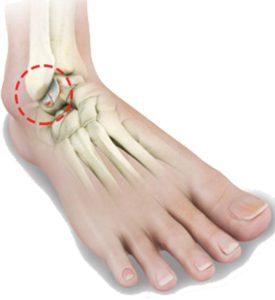By Arlo Yaege, DPM
 If you are like one of the many, and you suffer from arthritis of your ankle, which causes you to experience pain and discomfort on a daily basis, there are more options today to help you return to a better quality of life and activity level.
If you are like one of the many, and you suffer from arthritis of your ankle, which causes you to experience pain and discomfort on a daily basis, there are more options today to help you return to a better quality of life and activity level.
Ankle pain could have easily started from a mild ankle sprain, which you may have suffered many years ago. With that sprain the orientation of the ankle was altered thus causing damage to the cartilage. When cartilage is damaged from the initial injury, each step you take causes loading on the joint and continues to cause further damage. Over time, arthritic changes occur, irritating the joint capsule causing pain. One may experience pain with each step that feels like it is in the center of the ankle, or to one side of the joint. For some, they experience a tightness in the joint that is more symptomatic in the morning or after rest, and as the day progresses the joint may loosen up. Some patients experience pain and swelling that increases throughout the day, with respect to activity.
There are treatments that one can try on their own, such as: rest, ice, elevate, reduced activity, compression ankle support braces. Over the counter medications that one may take, including anti-inflamma-
tories and analgesics. If these self-treatments do not help, and or one is concerned, then it is time to seek medical evaluation by a foot and ankle surgeon.
When you see a foot and ankle surgeon, they will perform a thorough clinical exam, and radiographic analysis. Based upon your evaluation, the surgeon may order further diagnostic exams, which will aid in treatment options, such as: Computed Tomography (CT / Cat Scan), Magnetic Resonance Imaging (MRI). There are some non-surgical treatments that are available to you. Your surgeon may utilize steroid injections which will work to reduce your symptoms of inflammation and pain into the joint, but these injections can be limited on how many you may have per year. There are more supportive braces that are available; however, if possible, they are more beneficial if not used all the time. I believe that if a patient requires the use of a brace from the moment they wake up until the end of the day, then it is time for surgical options. But if a patient only needs the brace during periods of increased activities, then surgery may not warranted. If the patient is not medically stable to have surgery, then the brace is their best option.
When all non-surgical treatments have failed, then it may be time to discuss surgical options, so what can one expect to hear from their surgeon? One may hear, Arthroscopic, fusion of the ankle joint (arthrodesis), or total joint replacement. Patients ask about injectable gel for their ankles, like the ones they may have received for their knees, but at this time the Federal Drug Administration (FDA) has not cleared those injections for use in the ankle.
Some patients will benefit from arthroscopic surgery, which utilizing two small incision to allow access into the ankle joint with a camera and instruments used to clean, remove debris, and repair. Arthroscopic surgery can have a shorter post-operative recovery, when compared to other procedures.
Considered to be the Gold Standard for surgical treatment of a severely arthritic joint, is fusion of the joint commonly known as Arthrodesis. Arthrodesis is essentially the removal of the joint, and fixating the two sides of the joint into one bone instead of two. Recovery from fusion can take up to 12 to 16 weeks with half of the time unable to put weight on the surgical site. Eventually one may need a rocker bottom style shoe to help compensate for the loss of motion to assist in walking.
Over many years different iterations have been developed with respect to ankle replacements, but the majority required extensive post-operative restrictions and protocols, and what was known as
an anterior approach. Anterior approach refers to location of the incision at the ankle, the incision was in the front of the ankle. This area has some of the thinnest tissue and the greatest collection of vital structures; thus, increasing the risks for complications from surgery. However, there is now a Trabecular Metal Total Ankle replacement that uses a lateral approach, the incision is on the outside of the ankle, where the skin is thicker and there are less vital structures. This new implant also follows the body’s anatomy, and allows for early weight bearing. I have seen patients return to standing one week out from surgery with increased motion at the joint, this can improve the patient’s surgical outcome.
What is the goal? To reduce the patient’s symptoms, increase motion and activity; all of which to improve their quality of living.
Arlo Yaege, DPM
Dr. Arlo Yaege completed his undergraduate studies at Florida State University in Tallahassee, FL where he majored in Chemistry with a Minor in Mathematics with an emphasis on Physics. He then
attended Barry University School of Podiatric Medicine in Miami Shores, FL where he was on the Academic Dean’s List multiple times while working toward his DPM degree in 2006.
After graduating podiatry school Dr. Yaege completed a Podiatric Surgical Residency at University of Pittsburgh before joining Foot and Ankle Centers of Charlotte County.
Dr. Yaege has been in Private Practice since 2009. He is an active member of several professional podiatry organizations.
Foot and Ankle Centers
352 Milus Street, Punta Gorda, FL 33950
3406 Tamiami Trail, Suite 1, Port Charlotte, FL 33952
941-639-0025 | www.ccfootcare.com








